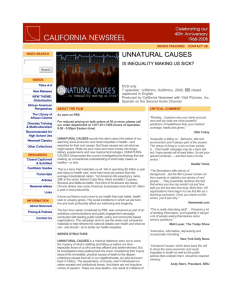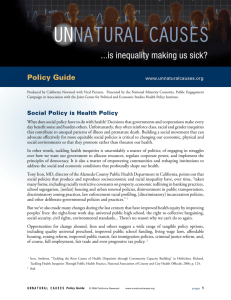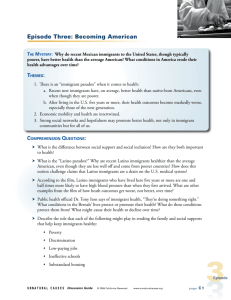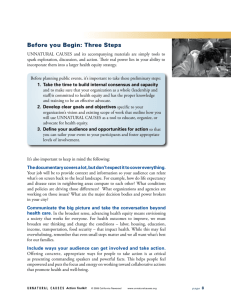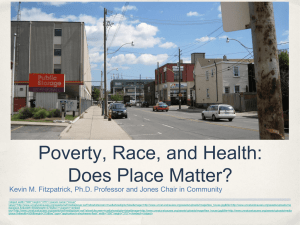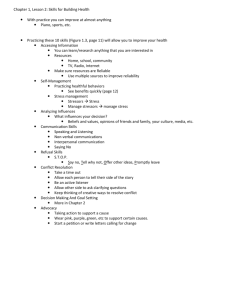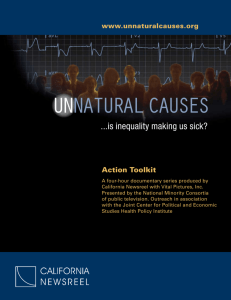Unnatural Causes: Health Inequities Discussion Guide
advertisement
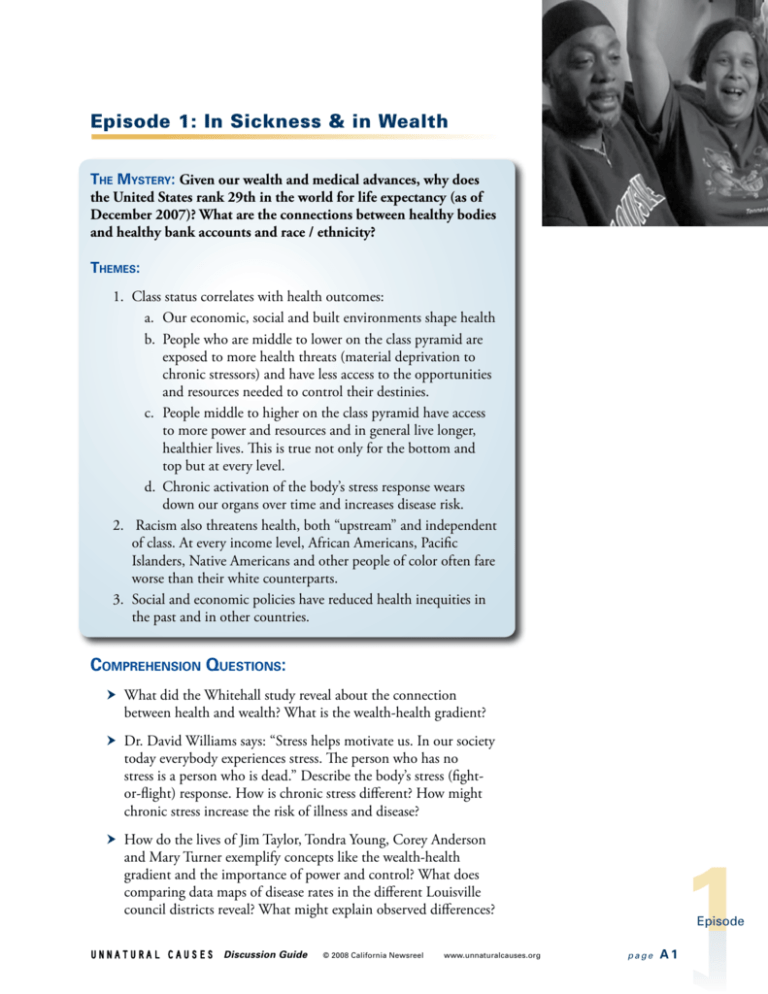
Episode 1: In Sickness & in Wealth The Mystery: Given our wealth and medical advances, why does the United States rank 29th in the world for life expectancy (as of December 2007)? What are the connections between healthy bodies and healthy bank accounts and race / ethnicity? Themes: 1. Class status correlates with health outcomes: a. Our economic, social and built environments shape health b. People who are middle to lower on the class pyramid are exposed to more health threats (material deprivation to chronic stressors) and have less access to the opportunities and resources needed to control their destinies. c. People middle to higher on the class pyramid have access to more power and resources and in general live longer, healthier lives. This is true not only for the bottom and top but at every level. d. Chronic activation of the body’s stress response wears down our organs over time and increases disease risk. 2.Racism also threatens health, both “upstream” and independent of class. At every income level, African Americans, Pacific Islanders, Native Americans and other people of color often fare worse than their white counterparts. 3. Social and economic policies have reduced health inequities in the past and in other countries. Comprehension Questions: What did the Whitehall study reveal about the connection between health and wealth? What is the wealth-health gradient? Dr. David Williams says: “Stress helps motivate us. In our society today everybody experiences stress. The person who has no stress is a person who is dead.” Describe the body’s stress (fightor-flight) response. How is chronic stress different? How might chronic stress increase the risk of illness and disease? How do the lives of Jim Taylor, Tondra Young, Corey Anderson and Mary Turner exemplify concepts like the wealth-health gradient and the importance of power and control? What does comparing data maps of disease rates in the different Louisville council districts reveal? What might explain observed differences? Unnatural C auses Discussion Guide © 2008 California Newsreel www.unnaturalcauses.org Episode page A1 Professor Leonard Syme defines control of destiny as the “ability to influence the events that impinge on your life.” Why is this ability an important factor for health? • What stories from Corey Anderson’s life exemplify a high demand / low control job and stressful home situation? • What stories from Jim Taylor’s life illustrate how wealth, power and status translate into better health? What did the Macaque monkey research teach primatologist Carol Shively about the connections between power, subordination and health? What parallels can we draw to human society? Describe examples from the film that illustrate how racism imposes an additional health burden on people of color. Give examples of both “everyday” racism (being treated unfairly) and “structural” racism (access to resources, power, status and wealth) and describe how these might affect health in different ways. What social changes were most responsible for the 30-year increase in American life expectancy over the 20th century? What policies does the film point to that might account for our low rank in recent years compared to other countries (29th as of December 2007)? What characterizes the policies and priorities of countries that have better health outcomes than we do? Discussion Questions: Dr. Adewale Troutman says that he promotes individual responsibility, but always within the context of social determinants. Why does he link the two? What is missing if we focus exclusively on individual responsibility? How does this affect possibilities for change? Dr. Ichiro Kawachi observes that the ability to avoid smoking and eat a healthy diet depends on access to “income, education, and the social determinants of health.” Do conditions in your community promote or hinder healthy choices? What policies shape those conditions? Angelique Anderson says: “I always wanted to have a house with a big back yard...” Corey adds: “I want to own a house so that if anything happened to me, she wouldn’t be put out on the street.” • What health benefits might derive from affordable, quality and secure housing? • How does home ownership (or its lack) affect conditions in your community? • How easy or difficult is it to find quality, affordable housing in your community? Unnatural C auses Discussion Guide © 2008 California Newsreel www.unnaturalcauses.org Episode page A2 Some chronic stressors mentioned in the film are: being on guard all the time, having little control at work, living in an unsafe neighborhood, being uncertain about where food will come from, and worrying about one’s children. • What additional stressors can you think of? • How does exposures to stressors—and resources available to manage them—vary with class position? • Describe the societal forces that create and reinforce these stressors. • What additional set of stressors might racism impose? Dr. Troutman says: “There’s almost a cultural demarcation in the city where on one side of this particular street, Ninth Street, there’s a tremendous amount of new development going on, condos rising up….And right across the street is where the public housing projects begin…. Every city has a Ninth Street.” • Where is the Ninth Street, the dividing line, in your city or area? • How would you characterize either side of the line? List and compare the health promoters and health threats. • Who lives there and who doesn’t? Why? • Were these areas different in the past? What government, land use, development and other investment decisions changed them? Dr. Jack Shonkoff, when talking about early childhood, says, “The concept here is the pile-up of risk, the cumulative burden of having things that are increasing your chances of having problems, as opposed to the cumulative protection of having things in your life that increase the likelihood that you can have better outcomes.” What are examples of the “pile up” of cumulative advantage—and disadvantage? • Sociologist David Williams say, “Economic policy is health policy.” How has U.S. influenced health inequities and health outcomes? What kinds of economic policies might reduce health inequities and improve the overall health of most Americans? Episode Unnatural C auses Discussion Guide © 2008 California Newsreel www.unnaturalcauses.org page A3 The film notes that sweeping social reforms made during the Progressive Era, the New Deal, and the Civil Rights Movement improved population health. • Why would changes that promote greater equity translate into population health improvements? • What do you notice about whether those policies or programs emphasized medical advances, greater individual responsibility, new programs and services, or structural and social change? • Should knowing about the health effects of social policies change the value that Americans place on these kinds of policies? Why or why not? Whitehall study director Sir Michael Marmot says, “If inequalities in health were a fixed property of society, then you’d say, ‘We can’t do anything about it.’ But that’s not the case. The magnitude of inequalities in health changes over time. It can get rapidly worse, and if it can get rapidly worse, it ought to be possible to make it rapidly better.” Describe how the policies below might promote better health for everyone. What other policies or social changes might you add to this list: Existing: 8-hour work day Minimum wage Unemployment insurance Free K-12 public education Affirmative action (limited) Social security Potential: Guaranteed paid vacation Living wage Job training and placement Paid parental leave Housing assistance Universal health care What kinds of employment, education, housing, or transportation polices do we need today to promote health equity? What obstacles and opportunities exist? How are strategies for social change different than programs for repairing damage? How would power have to shift? What does that mean? Episode Unnatural C auses Discussion Guide © 2008 California Newsreel www.unnaturalcauses.org page A4 Suggested Activity: Mapping Community Assets This activity helps participants identify sources of stress and support in their lives and think about ways they might increase their level of power and control. 1. The following chart lists areas that are potentially positive or negative in people’s lives, depending on their circumstances. As a group or individually, have participants think about each topic, decide whether it is a health threat and stressor or a resource in their life/community and explain why. Note: there may be multiple, even contradictory, answers per topic. (NOTE: This activity can also be adapted for use in and around workplace and labor policy issues) RESOURCES STRESSORS Food Access and Availability Quality Education Good Transportation / Planning Affordable Housing Good Jobs & Work Opportunities Business Investment and Development Income and Wealth Social Supports Public Safety Green Spaces Recreational Opportunities (We recommend copying this diagram onto a blackboard or creating your own handout based on these or your own categories. See the UNNATURAL CAUSES Policy Guide for other suggestions). 2. As a group, ask participants to share thoughts about the results. What patterns do you observe? How do neighboring communities compare? How do you feel about this snapshot of your life or community? What does it fail to capture? Unnatural C auses Discussion Guide © 2008 California Newsreel www.unnaturalcauses.org Episode page A5 3. Together, pick a few stressors and health threats to discuss. Brainstorm ideas for how each might be turned into a resource, including how you might use existing resources in other areas to accomplish this. What challenges might surface? What policy arenas need to be engaged? What opportunities exist for mobilizing people into action? 4. Turning your attention to existing resources, pick a few and ask, what makes the existence of these resources possible? What might threaten them? How can they be sustained or further developed? What policies and / or political action might strengthen and protect them? 5. Before ending the activity, solicit suggestions from the group about next steps and further actions that can be taken. Depending on the readiness of your group, these might even take the form of guiding principles or goals, such as the recommendations Dr. Troutman makes in the film: • Encourage economic development in low-income neighborhoods • Use zoning laws to restrict fast-food outlets and encourage grocery stores in low-income neighborhoods • Improve routes and reliability of public transportation • Create more equitable school financing formulas • Construct quality low-cost housing in integrated, mixed income neighborhoods Web Site Tips: Online Activity: Explore YOYO Health to see how the U.S. compares with other countries on a number of key indicators. Online Activity: Test your knowledge with our Health Equity Quiz! Resource: See how socioeconomic status and health outcomes are distributed across four Louisville Council Districts in Mapping Health and Inequity across Louisville (PDF) in our Health Equity database. Episode Unnatural C auses Discussion Guide © 2008 California Newsreel www.unnaturalcauses.org page A6 Key References: Cohen, S., J.E. Schwartz, E. Epel, C. Kirschbaum, S. Sidney, and T. Seeman. “Socioeconomic Status, Race, and Diurnal Cortisol Decline in the Coronary Artery Risk Development in Young Adults (CARDIA) Study,” Psychosomatic Medicine, 68 (2006): 41-50. Daniels, Norman, Bruce P. Kennedy, and Ichiro Kawachi. “Why Justice Is Good for Our Health: The Social Determinants of Health Inequalities,” Daedalus 128 no. 4 (1999): 215-251. Hofrichter, Richard, ed. Health and Social Justice: Politics, Ideology, and Inequity in the Distribution of Disease. San Francisco: Jossey-Bass, 2003. House, J.S. and Williams, D.R. “Understanding and Reducing Socioeconomic and Racial/Ethnic Disparities in Health” in Promoting Health: Intervention Strategies from Social and Behavioral Research ed. B.D. Smedley & S.L. Syme, 81-124. Washington, DC: National Academy of Sciences, 2000. Kubzansky, Laura D., Nancy Krieger, Ichiro Kawachi, Beverly Rockhill, Gillian K. Steel and Lisa Berkman. “Social Inequality and the Burden of Poor Health” in Challenging Inequities in Health: From Ethics to Action, ed. Timothy Evans et al. NY: Oxford, 2001. Marmot, Michael, G. Davey Smith et al. “Health Inequalities among British Civil Servants: The Whitehall II Study,” Lancet 337 (1991): 1387-1393. Satcher, David, George E. Fryer, Jr., Jessica McCann, Adewale Troutman, Steven H. Woolf and George Rust. “What If We Were Equal? A Comparison of the Black-White Mortality Gap in 1960 and 2000,” Health Affairs, 24 no. 2 (2005): 459-464. The Web site for Louisville’s Center for Health Equity (founded by Dr. Adewale Troutman) includes definitions of key terms related to health equity and an excellent set of links to national and international health organizations: www.louisvilleky.gov/Health/equity/ From the film: • Americans spend $2 trillion annually on medical care, nearly half of all health dollars spent in the world. • Among industrialized nations, the U.S. ranks 29th in life expectancy. • 47 million Americans have no health insurance. • In the U.S., the wealth of the top 1% is greater than the combined wealth of the bottom 90%. • The majority of poor people in the U.S. are white. • A 2005 study revealed that each year, more than 83,000 preventable African American deaths are attributable to the Black-white mortality gap. • People who grew up in a house owned by their parents are less likely to get sick as adults when exposed to a cold virus. Episode Unnatural C auses Discussion Guide © 2008 California Newsreel www.unnaturalcauses.org page A7
